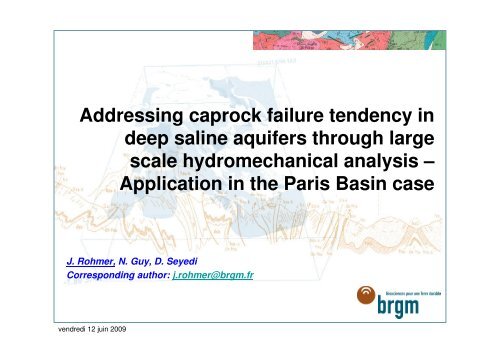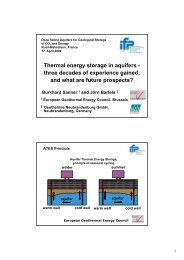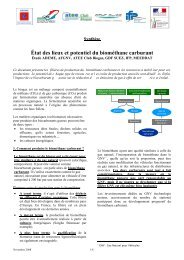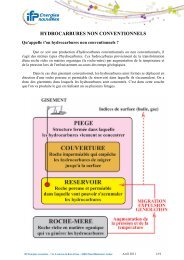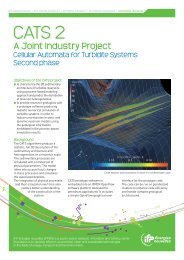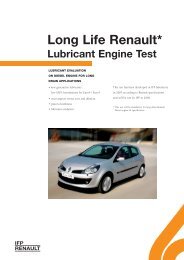Addressing caprock failure tendency in deep saline aquifers through ...
Addressing caprock failure tendency in deep saline aquifers through ...
Addressing caprock failure tendency in deep saline aquifers through ...
You also want an ePaper? Increase the reach of your titles
YUMPU automatically turns print PDFs into web optimized ePapers that Google loves.
<strong>Address<strong>in</strong>g</strong> <strong>caprock</strong> <strong>failure</strong> <strong>tendency</strong> <strong>in</strong><br />
<strong>deep</strong> sal<strong>in</strong>e <strong>aquifers</strong> <strong>through</strong> large<br />
scale hydromechanical analysis –<br />
Application <strong>in</strong> the Paris Bas<strong>in</strong> case<br />
J. Rohmer, N. Guy, D. Seyedi<br />
Correspond<strong>in</strong>g author: j.rohmer@brgm.fr<br />
vendredi 12 ju<strong>in</strong> 2009
Introduction<br />
> Injection of supercritical Co2<br />
→ changes <strong>in</strong> the effective stress components {σ’3 ; σ’1}<br />
surround<strong>in</strong>g the aquifer reservoir (e.g. Rutqvist et al., 2007 ; Vidal-<br />
Gilbert et al., 2008)<br />
> → Potential <strong>caprock</strong> <strong>failure</strong> (creation of new fractures or<br />
reactivation of pre-exist<strong>in</strong>g fractures)<br />
→ Potential pathways for the Co2 to escape from the aquifer reservoir<br />
→ Potential risks for the humans and the environment (Holloway, 1997)<br />
→ Decrease of the efficiency of the storage to mitigate climate change<br />
> Huge amount of uncerta<strong>in</strong>ties on the <strong>caprock</strong> properties<br />
(hydraulic and mechanical)<br />
→ They have seen less exploration than <strong>caprock</strong>s of Oil and Gas<br />
reservoirs<br />
→ They have not proven to conf<strong>in</strong>e buoyant fluids for geological time<br />
scale as for Oil and Gas reservoirs<br />
vendredi 12 ju<strong>in</strong> 2009 > 2
Introduction<br />
1. Caprock <strong>failure</strong> assessment methodology<br />
2. Description of the large scale hydromechanical<br />
model of the Paris bas<strong>in</strong> case<br />
3. Methodology to deal with the lack of knowledge of<br />
the <strong>caprock</strong> layer<br />
4. Caprock <strong>failure</strong> assessment <strong>in</strong> the <strong>in</strong>jection zone at<br />
the <strong>in</strong>terface between the <strong>caprock</strong> and the reservoir<br />
layer<br />
vendredi 12 ju<strong>in</strong> 2009 > 3
Cap Rock <strong>failure</strong> mechanism<br />
Failure mechanism n°1<br />
Tensile Fractur<strong>in</strong>g<br />
'<br />
σ 3 ≤<br />
0<br />
Assumption :<br />
tensile strength Rt = 0<br />
See for <strong>in</strong>stance: Rutqvist et al., 2007<br />
vendredi 12 ju<strong>in</strong> 2009 > 42
Cap Rock <strong>failure</strong> mechanism<br />
Failure mechanism n°1<br />
Tensile Fractur<strong>in</strong>g<br />
'<br />
σ 3 ≤<br />
0<br />
Assumption :<br />
tensile strength Rt = 0<br />
See for <strong>in</strong>stance: Rutqvist et al., 2007<br />
Failure mechanism n°2<br />
Shear slip<br />
σ σ 3<br />
' '<br />
1 /<br />
vendredi 12 ju<strong>in</strong> 2009 > 52<br />
≥<br />
q<br />
Assumption :<br />
Pre exist<strong>in</strong>g fracture with no cohesion<br />
q ≈ 2 for a angle of <strong>in</strong>ternal friction ϕ’ of 20°
Methodology : sequential coupl<strong>in</strong>g<br />
> Fluid and Heat Transport analysis<br />
• Tough2 (Pruess et al., 1999)<br />
• Fluid property module ECO2N of water–NaCl–CO2 mixtures (Pruess, 2005)<br />
vendredi 12 ju<strong>in</strong> 2009 > 62
Methodology : sequential coupl<strong>in</strong>g<br />
b Biot coefficient, P pore pressure, σ’ effective stress, σ total stress (e.g. Coussy, 1995)<br />
> Fluid and Heat Transport analysis<br />
• Tough2 (Pruess et al., 1999)<br />
• Fluid property module ECO2N of water–NaCl–CO2 mixtures (Pruess, 2005)<br />
> Stress and Stra<strong>in</strong> analysis<br />
• F<strong>in</strong>ite element thermo-hydro-mechanical calculation code : Code_Aster® (e.g.<br />
Chavant et al., 2002)<br />
vendredi 12 ju<strong>in</strong> 2009 > 72
Methodology : sequential coupl<strong>in</strong>g<br />
b Biot coefficient, P pore pressure, σ’ effective stress, σ total stress (e.g. Coussy, 1995)<br />
> Fluid and Heat Transport analysis<br />
• Tough2 (Pruess et al., 1999)<br />
• Fluid property module ECO2N of water–NaCl–CO2 mixtures (Pruess, 2005)<br />
> Stress and Stra<strong>in</strong> analysis<br />
• F<strong>in</strong>ite element thermo-hydro-mechanical calculation code : Code_Aster® (e.g.<br />
Chavant et al., 2002)<br />
vendredi 12 ju<strong>in</strong> 2009 > 82
Paris = Multilayered Geological System<br />
Layer Lithology Geological<br />
unit<br />
Thickness<br />
(m)<br />
Depth<br />
(m)<br />
Hydrostratigraphy<br />
N°1 Chalk Upper<br />
Cretaceous<br />
500 500 Semi permeable<br />
N°2<br />
N°3<br />
Clay and Shale<br />
Sandstone<br />
Albian and<br />
Cenomanian<br />
Albian<br />
60<br />
100<br />
560<br />
660<br />
Low permeable<br />
High permeable<br />
N°4<br />
Clay and Shale Lower<br />
Cretaceous and<br />
200 860 Low permeable<br />
Purbeckian<br />
N°5<br />
N°6<br />
Limestone<br />
Shale<br />
Thitonian<br />
Kimmeridgian<br />
150<br />
150<br />
1010<br />
1160<br />
High permeable<br />
Low permeable<br />
N°7 Limestone Oxfordian and<br />
Kimmeridgian<br />
300 1460 High permeable<br />
N°8<br />
N°9<br />
Clay and Shale<br />
Limestone<br />
Oxfordian and<br />
Callovian<br />
Upper Dogger<br />
90<br />
150<br />
1550<br />
1700<br />
Low permeability<br />
High permeable<br />
N°10 Limestone<br />
(tight)<br />
Lower Dogger 150 1850 Semi to low<br />
permeable<br />
N°11 Clay Lias 400 2250 Low permeable<br />
Based on the PICOREF project (Grataloup et al., 2008)<br />
Caprock layer<br />
Reservoir layer<br />
vendredi 12 ju<strong>in</strong> 2009 > 9<br />
1<br />
2<br />
4<br />
6<br />
8<br />
11<br />
3<br />
5<br />
7<br />
9&10
Co2 Injection Scenario<br />
Injection rate: 320 kg/s of supercitical Co2 ~10 Mt / y<br />
dur<strong>in</strong>g 10 years<br />
Axisymmetric model<br />
Large extent of 100 km<br />
Initial hydrostatic pressure<br />
Isothermal behaviour gradT=0.041 °C/m<br />
Sal<strong>in</strong>ity of 35 g/l <strong>in</strong> the Dogger reservoir<br />
No mechanical effect on the hydraulic properties<br />
No pore diffusivity<br />
No geochemical degradation<br />
In particular, hydraulic and mechanical properties of the<br />
Dogger reservoir based on measurements for geothermal<br />
activities (Rojas et al., 1989, Andre et al., 2007)<br />
vendredi 12 ju<strong>in</strong> 2009 > > 102
Uncerta<strong>in</strong>ty on the Caprock hydraulic properties<br />
Observation : the <strong>caprock</strong> properties have an important <strong>in</strong>fluence on the<br />
overpressure at the <strong>in</strong>terface with the reservoir aquifer layer (Birkholzer et al., 2009)<br />
Objective : def<strong>in</strong>e the <strong>caprock</strong> properties so that the overpressure is maximum =<br />
critical configuration<br />
Property<br />
Intr<strong>in</strong>sic permeability<br />
Permeability<br />
anisotropy<br />
Porosity<br />
Symbol Lower<br />
bound<br />
Upper<br />
bound<br />
Kh 5.e-5 1.0 mD<br />
A 1/100 1/10 (-)<br />
ω 5 15 %<br />
Van Genuchten<br />
parameter P0 1 8 MPa<br />
Unit Reference<br />
Lab test of the Geocarbone<br />
Integrity project, Fleury et al.,<br />
2007<br />
Andra, 2005<br />
Assumed<br />
Lab test of the Geocarbone<br />
Integrity project, Fleury et al.,<br />
vendredi 12 ju<strong>in</strong> 2009 > > 112<br />
2007<br />
Lab test of the Geocarbone<br />
Integrity project, Fleury et al.,<br />
2007<br />
Andra, 2005<br />
Andre et al., 2007<br />
Bachu and Bennion, 2007<br />
Van Genuchten<br />
parameter<br />
λ 0.330 0.600 (-)<br />
Residual Water<br />
saturation<br />
Slr 20 30 %<br />
Birkholzer et al., 2009<br />
Residual Gas<br />
saturation<br />
Sgr 5 35 %<br />
Bachu and Bennion, 2007<br />
Birkholzer et al., 2009<br />
Pore compressibility C 4.5e-10 9.0e-10 Pa-1 Birkholzer et al., 2009
Methodology<br />
Response surface method (Box and Draper, 1987)<br />
Step 1 « tra<strong>in</strong><strong>in</strong>g data »: simulate the <strong>in</strong>jection for a f<strong>in</strong>ite number of<br />
configurations of the <strong>caprock</strong> properties<br />
Configurations of the <strong>caprock</strong> properties are randomly generated<br />
(Lat<strong>in</strong> Hypercube Sampl<strong>in</strong>g method, McKay et al., 1979)<br />
Step 2 « approximation »: of the pressure build up by means of a l<strong>in</strong>ear<br />
regression model<br />
Coefficient of determ<strong>in</strong>ation R²=92 %<br />
Step 3 « validation »: of the approximation quality <strong>through</strong> Leave One<br />
Out Cross Validation Procedure LOOCV (e.g. Hjorth, 1994)<br />
Coefficient of determ<strong>in</strong>ation R²=85 %<br />
Step 4 « Critical configuration » : for which the overpressure<br />
<strong>in</strong> the <strong>in</strong>jection zone is maximum<br />
« Worst case » cf. EC Directive on CCS operations (Annex I, 3.3.4<br />
Risk characterisation)<br />
vendredi 12 ju<strong>in</strong> 2009 > > 122
Critical configuration of Caprock hydraulic properties<br />
Most<br />
sensitive<br />
Property<br />
Configuration<br />
for M<strong>in</strong>imum<br />
Overpressure<br />
Configuration<br />
for Maximum<br />
Overpressure<br />
vendredi 12 ju<strong>in</strong> 2009 > > 132<br />
Unit<br />
Porosity ω 15 5 %<br />
permeability<br />
Kh<br />
1.0 5.e-5<br />
mD<br />
Residual Gas<br />
%<br />
Saturation<br />
Sgr<br />
35 5<br />
Anisotropy A 1/10 1/100 (-)
Overpressure evolution <strong>in</strong> the <strong>in</strong>jection zone at the<br />
<strong>in</strong>terface betw. the reservoir and the <strong>caprock</strong> layer<br />
Overpressure (bars)<br />
Overpressure (bars)<br />
80<br />
70<br />
60<br />
50<br />
40<br />
30<br />
20<br />
10<br />
0<br />
Configuration for M<strong>in</strong>imum Overpressure<br />
Configuration for Maximum Overpressure<br />
0 1 2 3 4 5 6 7 8 9 10<br />
Injection date (year)<br />
Year of Injection<br />
18 bars<br />
vendredi 12 ju<strong>in</strong> 2009 > > 142
Overpressure after 10 y of <strong>in</strong>jection<br />
Maximum Overpressure at the <strong>in</strong>terface between the <strong>caprock</strong> and the reservoir layer<br />
M<strong>in</strong>imum Overpressure at the <strong>in</strong>terface between the <strong>caprock</strong> and the reservoir layer<br />
Injection zone<br />
vendredi 12 ju<strong>in</strong> 2009 > > 152
Overpressure after 10 y of <strong>in</strong>jection<br />
Maximum Overpressure at the <strong>in</strong>terface between the <strong>caprock</strong> and the reservoir layer<br />
Large lateral impact (consistent with Birkholzer et al., 2009)<br />
M<strong>in</strong>imum Overpressure at the <strong>in</strong>terface between the <strong>caprock</strong> and the reservoir layer<br />
Large vertical impact (consistent with Birkholzer et al., 2009)<br />
Injection zone<br />
vendredi 12 ju<strong>in</strong> 2009 > > 162
Uncerta<strong>in</strong>ty on the Caprock mechanical properties<br />
Property<br />
Symbol Lower<br />
bound<br />
Upper<br />
bound<br />
Unit Reference<br />
Young’s Modulus E 2.3 11.0 GPa Andra, 2005 and Bounneni,<br />
2002<br />
Poisson’s ratio υ 0.17 0.40 GPa Andra, 2005 and Bounneni,<br />
2002<br />
Objective : def<strong>in</strong>e the <strong>caprock</strong> elastic properties so that the <strong>caprock</strong> <strong>failure</strong> risk is MAX<br />
vendredi 12 ju<strong>in</strong> 2009 > > 172
Uncerta<strong>in</strong>ty on the Caprock mechanical properties<br />
Property<br />
Symbol Lower<br />
bound<br />
Upper<br />
bound<br />
Unit Reference<br />
Young’s Modulus E 2.3 11.0 GPa Andra, 2005 and Bounneni,<br />
2002<br />
Poisson’s ratio υ 0.17 0.40 GPa Andra, 2005 and Bounneni,<br />
2002<br />
Objective : def<strong>in</strong>e the <strong>caprock</strong> elastic properties so that the <strong>caprock</strong> <strong>failure</strong> risk is MAX<br />
Step 1 « tra<strong>in</strong><strong>in</strong>g data »:<br />
Configurations of the <strong>caprock</strong> mechanical properties are randomly generated<br />
Failure mechanism n°1<br />
Tensile Fractur<strong>in</strong>g<br />
'<br />
σ<br />
3 ≤<br />
Step 2 « approximation » by a l<strong>in</strong>ear<br />
regression model<br />
Coefficient of determ<strong>in</strong>ation R²=98.4 %<br />
Step 3 « validation »:<br />
Coefficient of determ<strong>in</strong>ation R²=94.53 %<br />
Step 4 « Critical configuration »:<br />
Importance measure of the Poisson’s<br />
ratio = 94.67 %<br />
m<strong>in</strong>imum σ’3 for υ=0.40<br />
0<br />
vendredi 12 ju<strong>in</strong> 2009 > > 182
Uncerta<strong>in</strong>ty on the Caprock mechanical properties<br />
Property<br />
Symbol Lower<br />
bound<br />
Upper<br />
bound<br />
Unit Reference<br />
Young’s Modulus E 2.3 11.0 GPa Andra, 2005 and Bounneni,<br />
2002<br />
Poisson’s ratio υ 0.17 0.40 GPa Andra, 2005 and Bounneni,<br />
2002<br />
Objective : def<strong>in</strong>e the <strong>caprock</strong> mechanical properties so that the <strong>caprock</strong> <strong>failure</strong> risk is MAX<br />
Step 1 « tra<strong>in</strong><strong>in</strong>g data »:<br />
Configurations of the <strong>caprock</strong> mechanical properties are randomly generated<br />
Failure mechanism n°1<br />
Tensile Fractur<strong>in</strong>g<br />
'<br />
σ 3 ≤<br />
Step 2 « approximation » by a l<strong>in</strong>ear<br />
regression model<br />
Coefficient of determ<strong>in</strong>ation R²=98.4 %<br />
Step 3 « validation »:<br />
Coefficient of determ<strong>in</strong>ation R²=94.53 %<br />
Step 4 « Critical configuration »:<br />
Importance measure of the Poisson’s<br />
ratio = 94.67 %<br />
m<strong>in</strong>imum σ’3 for υ=0.40<br />
0<br />
Failure mechanism n°2<br />
Shear slip<br />
σ σ 3<br />
' '<br />
1 /<br />
Step 2 « approximation » by a l<strong>in</strong>ear<br />
regression model<br />
Coefficient of determ<strong>in</strong>ation R²=99.23 %<br />
Step 3 « validation »:<br />
Coefficient of determ<strong>in</strong>ation R²=97.27 %<br />
Step 4 « Critical configuration »:<br />
Importance measure of the Poisson’s<br />
ratio = 94.61 %<br />
σ’1 /σ’3 is maximum<br />
for υ=0.40<br />
vendredi 12 ju<strong>in</strong> 2009 > > 192<br />
≥<br />
q
Mohr circle <strong>in</strong> the <strong>in</strong>jection zone at the <strong>in</strong>terface betw.<br />
the reservoir and the <strong>caprock</strong> layer<br />
Initial ratio betw. horizontal and vertical stress = 0.60 (Vidal-Gilbert et al., 2008)<br />
σ’3 = 11.5 MPa<br />
σ’3 = 9.22 MPa<br />
σ’1 /σ’3 = 1.55<br />
σ’1 /σ’3 = 1.75<br />
Shear reactivation criterion for a cohesionless fracture with q=3<br />
Shear reactivation criterion for a cohesionless fracture with q=2<br />
vendredi 12 ju<strong>in</strong> 2009 > > 202
Conclud<strong>in</strong>g remarks<br />
> The <strong>in</strong>jection-<strong>in</strong>duced overpressure is maximal <strong>in</strong> the <strong>in</strong>jection zone<br />
(distance < 100 m) =most critical one <strong>in</strong> the system.<br />
> The lateral extension of the “overpressurized” region is large (> 50 km).<br />
> Tensile fractur<strong>in</strong>g mechanism is not activated even for the worst case of<br />
the <strong>caprock</strong> properties<br />
> Shear slip reactivation of pre-exist<strong>in</strong>g cohesionless fractures might be<br />
possible but for low friction angle (q 21
Thank you for your attention !<br />
vendredi 12 ju<strong>in</strong> 2009 > 22
Bibliography<br />
> Andra (2005) Synthèse Argile : Evaluation de la faisabilité du stockage géologique en formation argileuse. 241 pages (<strong>in</strong> french).<br />
> André, L., Audigane, P., Azaroual, M., Menjoz, A. (2007) Numerical model<strong>in</strong>g of fluid–rock chemical <strong>in</strong>teractions at the supercritical<br />
CO2–liquid <strong>in</strong>terface dur<strong>in</strong>g CO2 <strong>in</strong>jection <strong>in</strong>to a carbonate reservoir, the Dogger aquifer (Paris Bas<strong>in</strong>, France). Energy Conversion and<br />
Management, 48, 6, 1782-1797.<br />
> Bachu, S. and Bennion, B., 2008 Effects of <strong>in</strong>-situ conditions on relative permeability characteristics of CO2-br<strong>in</strong>e systems,<br />
Environmental Geology, Volume 54, Issue 8, pp.1707-1722<br />
> Birkholzer, J.T., Zhou, Q., Tsang, C.-F., 2009. Large-scale impact of CO2 storage <strong>in</strong> <strong>deep</strong> sal<strong>in</strong>e <strong>aquifers</strong>: a sensitivity study on the<br />
pressure response <strong>in</strong> stratified systems. Int. J. of Greenhouse Gas Control 3, 181-194.<br />
> Box, G.E., Draper, N.R., 1987. Empirical model build<strong>in</strong>g and response surfaces, Wiley series <strong>in</strong> probability and mathematical statistics,<br />
John Wiley and Sons, New York, USA.<br />
> Chavant, C., Granet, S., Le Boulch, D. (2002) Modell<strong>in</strong>g of a nuclear waste disposal: numerical and practical aspects. Biot conference on<br />
poromechanics II, Rotterdam, the Netherlands.<br />
> Coussy, O. (1995) Mechanics of Porous Cont<strong>in</strong>ua (2nd edn), Wiley, Chichester, UK.<br />
> Fleury, M. (2007) The GeoCarbone-Integrity program: evaluat<strong>in</strong>g seal<strong>in</strong>g efficiency of <strong>caprock</strong>s for CO2 storage, 1st french-german<br />
symposium on geological storage of CO2, Potsdam, Germany.<br />
> Grataloup, S., Bonijoly, D., Brosse, E., Garcia., D., Hasanov., V., Lescanne, M., Renoux., P., Rigollet C., Thoraval., A. (2008) PICOREF:<br />
A site selection methodology for sal<strong>in</strong>e aquifer <strong>in</strong> Paris Bas<strong>in</strong>. 9th GHGT, Wash<strong>in</strong>gton, USA.<br />
> Hjorth, J.S.U., 1994. Computer Intensive Statistical Methods: Validation Model Selection and Bootstrap, Chapman and Hall, London, UK.<br />
> Holloway, S., 1997. Safety of the underground disposal of carbon dioxide. Energy Convers. Manag. 38, 241-245.<br />
> McKay, M.D., Beckman, R.J., Conover, W.J., 1979. A comparison of three methods for select<strong>in</strong>g values of <strong>in</strong>put variables <strong>in</strong> the analysis<br />
of output from a computer code. Technometrics 21, 239-245.<br />
> Pruess, K. (2005) ECO2N—a TOUGH2 fluid property module for mixtures of water, NaCl, and CO2. Lawrence Berkeley National<br />
Laboratory Report LBNL-57952<br />
> Pruess K, Oldenburg, C.M., Moridis, G.J. (1999) TOUGH2 user’s guide, version 2.0. Lawrence Berkeley National Laboratory Report<br />
LBNL-43134, Berkeley, CA, USA.<br />
> Rojas, J., Giot, D., Le N<strong>in</strong>dre, Y.M., Criaud, A., Fouillac, C., Brach, M. (1989) Caracterisation et modelisation du reservoir geothermique<br />
du Dogger, bass<strong>in</strong> parisien, France. Technical Report CCE, EN 3G-0046-F(CD), BRGM R 30 IRG SGN 89 (<strong>in</strong> french).<br />
> Rutqvist, J., Birkholzer, J.T., Cappa, F., Tsang, C.-F., 2007. Estimat<strong>in</strong>g maximum susta<strong>in</strong>able <strong>in</strong>jection pressure dur<strong>in</strong>g geological<br />
sequestration of CO2 us<strong>in</strong>g coupled fluid flow and geomechanical fault-slip analysis. Energy Convers. Manage. 48, 1798-1807.<br />
> Vidal-Gilbert, S., Nauroy, J-F., Brosse, E., 2008. 3D geomechanical modell<strong>in</strong>g for CO2 geologic storage <strong>in</strong> the Dogger carbonates of the<br />
Paris Bas<strong>in</strong>. Int. J. of Greenhouse Gas Control, (In Press), doi:10.1016/j.ijggc.2008.10.004<br />
vendredi 12 ju<strong>in</strong> 2009 > 23
Annex<br />
> Annex 1 : Co2 saturation field<br />
> Annex 2 : table of properties<br />
> Annex 3 : cross validation<br />
> Annex 4 : modell<strong>in</strong>g the Dogger reservoir<br />
vendredi 12 ju<strong>in</strong> 2009 > 24
Annex 1<br />
vendredi 12 ju<strong>in</strong> 2009 > 25
Annex 2<br />
Layer Van Genuchten’s<br />
parameter<br />
λ<br />
Residual<br />
liquid<br />
saturation<br />
[%]<br />
Residual gas<br />
saturation<br />
[%]<br />
Air entry<br />
pressure<br />
[bars]<br />
Carbonate <strong>aquifers</strong><br />
and Chalk aquifer<br />
0.600 20 5 0.54<br />
Sandstone aquifer 0.750 1.5 20 0.0358<br />
Clay and Shale<br />
<strong>in</strong>terlac<strong>in</strong>g layers<br />
0.329 30 5 50<br />
Caprock layer 0.329 30 5 80<br />
Reservoir layer 0.600 20 5 0.54<br />
Lower Dogger<br />
formation<br />
0.600 20 5 10<br />
Layer Young<br />
Modulus<br />
[GPa]<br />
Poisson<br />
ratio<br />
[-]<br />
Intr<strong>in</strong>sic<br />
permeability<br />
[mD]<br />
Ratio between<br />
horizontal<br />
and vertical<br />
permeability<br />
Chalk aquifer 5 0.3 1 1 30<br />
Clay and Shale<br />
<strong>in</strong>terlac<strong>in</strong>g layers<br />
6.65 0.285 0.001 10 5<br />
Sandstone aquifer 10 0.3 50000 2 25<br />
Carbonate 15 (upper) 0.3 100 1 15<br />
<strong>aquifers</strong><br />
20 (lower)<br />
Caprock layer 6.65 0.285 0.00005 10 5<br />
Dogger formation 24 0.29 705 for the high 10 15<br />
(reservoir)<br />
productive layer<br />
90 for the low<br />
productive layer<br />
Lower Dogger<br />
formation<br />
42 0.29 1 10 10<br />
Porosity<br />
[%]<br />
vendredi 12 ju<strong>in</strong> 2009 > 26
Annex 3<br />
vendredi 12 ju<strong>in</strong> 2009 > 27
Annex 4<br />
Heterogeneous system<br />
Production Tests for geothermal activities, Rojas et al., 1989<br />
One Equivalent Layer<br />
Three Equivalent<br />
Layers<br />
vendredi 12 ju<strong>in</strong> 2009 > > 282
Modell<strong>in</strong>g the Dogger reservoir<br />
Kh = 60mD, Kv = Kh /10, ω=15%<br />
Kh = 200mD, Kv = Kh /10, ω=15%<br />
P0 = 54 000 Pa, Slr = 20 %, λ=0.600<br />
Rojas et al., 1989 , Andre et al., 2007<br />
Transmissivity 14.6 D.m<br />
vendredi 12 ju<strong>in</strong> 2009 > > 292<br />
90 m


